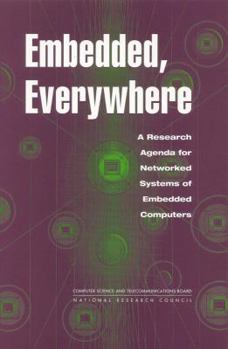Embedded, Everywhere: A Research Agenda for Networked Systems of Embedded Computers
Advances in the miniaturization and networking of microprocessors promise a day when networked computers are embedded throughout the everyday world. However, our current understanding of what such systems would be like is insufficient to bring the promise to reality. Embedded, Everywhere explores the potential of networked systems of embedded computers and the research challenges arising from embedding computation and communications...
Format:Paperback
Language:English
ISBN:0309075688
ISBN13:9780309075688
Release Date:October 2001
Publisher:National Academies Press
Length:235 Pages
Weight:0.90 lbs.
Dimensions:0.6" x 6.0" x 9.0"
Customer Reviews
2 ratings
Everything you need to know about embedded computers
Published by Thriftbooks.com User , 22 years ago
This report takes the view that information technology (IT) is on the verge of another revolution, driven by the increasing capabilities and ever declining costs of computing and communications. IT is being embedded into a growing range of physical devices linked together through networks and will become ever more pervasive as the component technologies become smaller, faster, and cheaper. These networked systems of embedded computers, referred to by this report as EmNets, have the potential to change radically the way people interact with their environment by linking together a range of devices and sensors that will allow information to be collected, shared, and processed in unprecedented ways. EmNets could be implemented as a kind of digital nervous system to enable instrumentation of all sorts of spaces. EmNets are expected be employed in personal monitoring strategies (both defense related and civilian), combining information from sensors on and within a person with information from laboratory tests and other sources; and EmNets will dramatically affect scientific data collection capabilities, ranging from new techniques for precision agriculture and biotechnological research to detailed environmental and pollution monitoring. The report expects EmNets to quite possibly dwarf previous milestones in the information revolution. It sees IT eventually becoming an invisible component of almost everything in everyone's surroundings. This 236-page report explores the potential of EmNets and the research challenges they present. It describes the many ways in which these emerging networks operate under unique constraints not present in more traditional distributed systems such as the Internet. A comprehensive, systems-oriented research agenda is presented along with recommendations to major federal funding agencies.
See the future
Published by Thriftbooks.com User , 22 years ago
Prognostication is a tough business to be in. The NationalResearch Council is routinely put into that position nevertheless--and we're better off for it. This work, "Embedded, Everywhere", isa work from some of the top people in Computer Science today andattempts to identify the issues relating to a world saturated withcomputing resources.EmNets, networked systems of embedded computers, are the centraltheme of the book. This isn't science fiction. Some of what is discussed in the work is already touching our lives. "It shouldcome as no surprise that the modern automobile is already a rollingnetwork of embedded computers. In model year 2001, cars have between 20 and 80 microprocessors controlling everything from therunning of the engine to the break system to the deployment ofthe airbags." While this certainly presents technical challenges,there are ethical ones as well. "Few automobile drivers, forexample, are currently aware that many cars collect and storeinformation about the way the car has been driven (e.g., drivingspeed, acceleration, engine speed). This information can be usedby manufacturers to better analyze accidents and, hence, improvesafety but could also be used to disallow warranty claims or toprove that an automobile was operated in an unsafe manner."Today's computing systems are complex and in amazing places. Yet,the book makes the following assertion: "...as the rest of thisreport makes clear, incremental improvement to today's solutionswill not suffice to realize the full potential of EmNets." Thebook then goes on to identify those problem areas and to makespecific recommendations for research into solving those problems.The book has an impressive list of authors. Deborah Estrin, professor of CS at UCLA was the committee chair andwas backed up by Mark Horowitz of Stanford, Barbara Liskov of MITand others from academia. This wasn't just some university exercise,however. Industry was also well represented on the effort with thelikes of Jerry Fiddler (founder and chairman of Wind River Systems),Robert Colwell (lead architect for the P6 at Intel), and Jim Waldo(Sun Microsystems and developer of the first CORBA ORB and laterJini Network Technology), to name a few.There is a hard-edged, practical feel to the extensive discussionsin this small book. Technical, architectural, methodological, social,and ethical concerns are explored in depth. Predicting the future is difficult. Luckily, you don't need to.Just follow the research initiatives and they will light the path.





